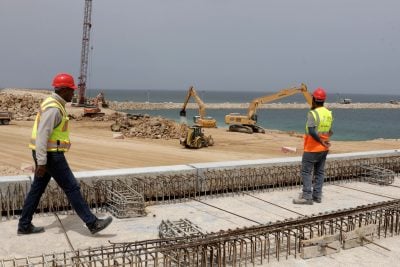This year, Mauritania has not only joined the exclusive club of countries with large hydrocarbon and mineral reserves, but has also given a very strong boost to the development of renewable energies, making it a player in the world of the energy transition.
The country has signed two large-scale green hydrogen projects in recent months. Green hydrogen is a clean energy produced by electrolysis of water from renewable electricity, such as wind or solar power, making it possible to decarbonise industries that create pollution, such as refining, chemicals and steel manufacturing.
It can also be used as fuel in transport, particularly maritime transport. In 2020, Goldman Sachs estimated that the global market for green hydrogen would be worth $1 trillion within 30 years.
At the beginning of September, the producer Total Eren (a subsidiary of the French oil company Total Energies, with revenues of €550m in 2021) and its parterner Chariot, a British junior company focused on Africa, announced their participation in the Nour project.
This was hardly a surprise to seasoned observers, as the two players have been concluding a series of agreements to jointly develop wind and solar projects with mining clients in Africa for several years.
The two players have already been working together since last February to supply solar photovoltaic energy to the Tharisa mine in South Africa, and since March to the copper mines of the Canadian First Quantum Minerals in Zambia, in addition to their cooperation since 2018 in photovoltaic energy in Burkina Faso around the Essakane gold mine of IAMGold.
Already present in two offshore gas fields in Morocco and in Namibia, Chariot, whichis headed by the South African mining magnate of Cypriot origin Adonis Pouroulis, is familiar with the Mauritanian terrain through its parent company, Pella Resources, which is involved in several gold and iron ore mining projects.
- Mauritania’s strategic vision
- Gas, the new deal for Mauritania
- Mauritania set to double iron production
- Mauritania rising: A new perspective for tackling the local content gap
The cheapest energy in the world
With a capacity of 10 GW, representing an investment of $3.5bn, Nour will be located near Nouadhibou, where it will be able to take full advantage of the wind and sun of this desert region.
According to Chariot, it will produce “the cheapest energy in the world”. By 2030, the price of green hydrogen is expected to be less than $2 a kilo, compared with $3-6 today. This is particularly attractive to the mining and oil sectors, which are keen to green their operations, reduce the energy costs of their off-grid oil and diesel operations and earn carbon credits. This makes green hydrogen an important ally for the clean development of the extractive industries in Mauritania.
Exports to Europe
But at a time when there are many tensions in the European energy market against the backdrop of the war in Ukraine, with threats of winter cuts and restrictions, rising costs, the closure of certain supplies and sabotage of gas pipelines, Mauritania can also use its geographical proximity to Europe to export its production there.
Chariot has already signed a partnership with the Port of Rotterdam tha could pave the way for the sale of 600,000 tonnes of green hydrogen per year. To cope with the growth of this new traffic, Rotterdam also announced the construction by 2026 of a terminal exclusively dedicated to this new resource and its derived products. This comes at a time when Europe wants to quadruple its use of green hydrogen to 75 GW, half of which will be imported, by 2035.
Ambitious projects in the pipeline
Faced with this potential and the natural advantages offered by Nouakchott, major global players have been quick to take a stand. At the end of May, after almost six months of negotiations, the government signed up for an even more ambitious project in the Dakhlet Nouadhibou and Inchiri regions with the Australian energy group CWP Global, which has more than 100 GW of projects under development and 1.5 GW operational worldwide.
The $40bn Aman project, with a capacity of 30 GW, consisting of 18 GW of solar and 12 GW of wind, will be “the largest renewable energy project in the world” according to the promoters.
According to CWP Global, it should increase Mauritania’s GDP by 40 to 50% by 2030 and by 50 to 60% by 2035. But the Australian company also promises other important benefits for the country: in addition to universal electrification, it should reduce unemployment in the country by one third within 15 years, and will contribute to cleaner development with the introduction of hydrogen-powered vehicles..
Green hydrogen could therefore become an additional attraction for ecologically minded new investors in the extractive sectors in Mauritania.
Want to continue reading? Subscribe today.
You've read all your free articles for this month! Subscribe now to enjoy full access to our content.
Digital Monthly
£8.00 / month
Receive full unlimited access to our articles, opinions, podcasts and more.
Digital Yearly
£70.00 / year
Our best value offer - save £26 and gain access to all of our digital content for an entire year!
 Sign in with Google
Sign in with Google 



